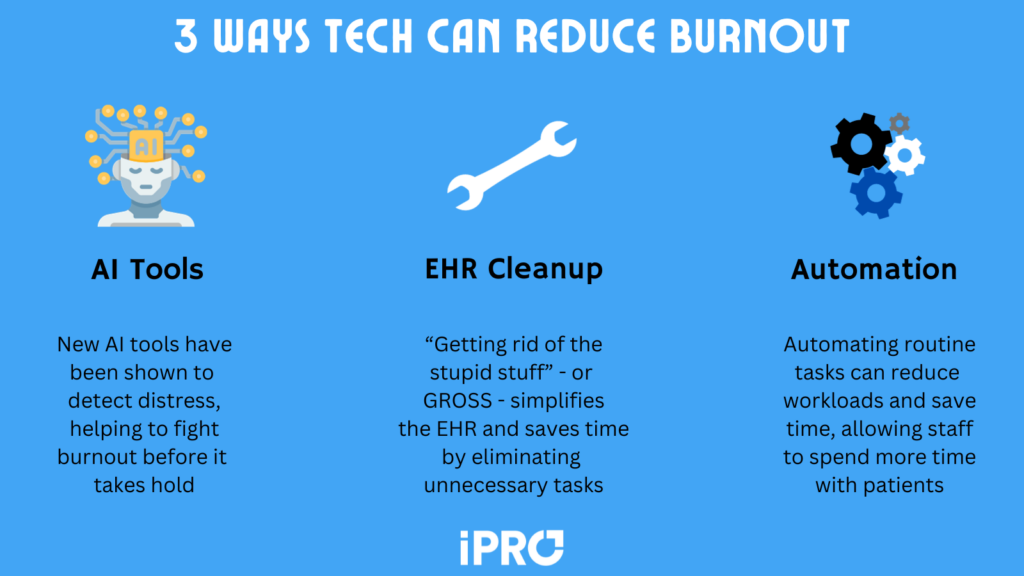(This article was originally published 11/20/23 and most recently updated 5/16/24)
It’s no secret that burnout is one of the biggest challenges in healthcare. A recent survey by MedScape found that 49% of physicians are burned out, and 20% are depressed. They’re not alone. Other specialties are experiencing high rates of burnout, such as radiology (36%).
While there are many tactics to combat burnout, let’s look at some ways technology can reduce burnout and improve the healthcare experience.
Short on time? Watch the byte-sized version of this blog.

AI Can Detect Distress
The use of AI in healthcare has been an exciting topic lately. Much of the focus on healthcare’s use of AI has been either on improving outcomes for patients or reducing healthcare workloads (which we’ll discuss later). These can certainly reduce burnout and improve the healthcare experience for both patients and providers.
A new potential use for AI could make tackling burnout even easier. In a recent study, AI was able to detect early signs of distress and anxiety among healthcare workers. The AI model is expected to improve its accuracy as more data becomes available. While more research may need to be done to ensure AI’s accuracy in detecting early signs of distress and anxiety, detecting these signs early can help fight burnout before it truly takes hold. This tool could also be used to detect depression and anxiety in patients and lead to better healthcare.
Eliminating the “Stupid Stuff”
Another way technology can reduce burnout is by using the “Getting Rid of the Stupid Stuff” initiative, or GROSS. Specifically, this refers to simplifying the EHR by eliminating unnecessary tasks and reducing the number of clicks and documentation. In 2017, Hawaii Pacific Health pioneered this initiative by asking their clinicians to identify “anything in the EHR that was poorly designed, unnecessary, or just plain nonsensical.” A panel then reviewed hundreds of submissions to determine which changes could and should be made. Submissions that made the cut were handed over to the appropriate teams for the changes to be made within the EHR system.
For HPH’s 7,000 employees, the GROSS initiative resulted in saving them thousands of hours of unnecessary work. The broader impact for the healthcare industry is that other health systems have been inspired to use the GROSS initiative by HPH’s success. For instance, Novant Health was able to eliminate an estimated 26 million EHR clicks, saving their employees as much as 4 years worth of work. The success of the GROSS initiative has even led to the American Medical Association (AMA) including a “GROSS module” in its STEPS forward practice improvement program.
Automation Reduces Workloads and Saves Time
As we touched on in the last 2 sections, automation is another way technology can reduce burnout. Automating routine tasks reduces workloads, giving clinical staff more time to spend with patients. Beth McCombs, Executive Vice President and Chief Technology Officer at AI vendor BD, addresses this in a recent Healthcare IT News article.
“Seemingly every healthcare professional I know chose the medical field to help patients, not to manage technology or perform administrative tasks.”
– Beth McCombs, EVP & Chief Technology Officer at BD
The article highlights AI as a means of automating routine tasks, such as monitoring patients’ vital signs or enhancing medical images. This allows providers to spend more time with patients. This leads to a better patient experience and better health outcomes. Technology can also reduce burnout through the following forms of automation:
- SMS-based patient engagement tools (appointment reminders, procedure instructions, etc.)
- Voice recognition and transcription software
- Order validation software that flags CPT code mismatches and ensures order accuracy
- Billing software that makes it easier for patients to pay their bills
Technology for a Better Future in Healthcare
To recap, 3 ways technology can reduce burnout and improve healthcare are:
- AI tools can detect distress
- Getting rid of the “stupid stuff” in EHR’s can streamline workflows, and
- Automation can reduce workloads

Utilizing technology in these ways gives healthcare workers more time to spend with patients, the reason they chose a career in healthcare. This helps generate better outcomes for patients and improve the patient experience.
At iPro, we offer tech solutions and service that help shape a better future in healthcare. Our suite of medical imaging solutions streamline workflows, reducing stress and burnout among staff and improving imaging outcomes for patients.




